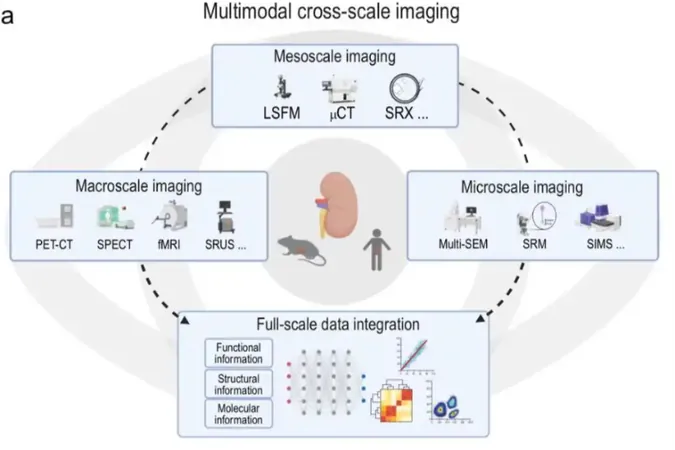
Pioneering 'Digital Kidney': A Revolutionary Advancement in Nephrology by Chinese Researchers
2025-04-01
Author: John Tan
Introduction
Researchers at Peking University have embarked on an innovative project known as the Kidney Imageomics Project, aiming to create a groundbreaking 'digital kidney.' This comprehensive digital atlas of the kidney will employ advanced multi-modal imaging technologies and sophisticated artificial intelligence algorithms to transform our understanding and management of kidney diseases.
The Challenge of Delayed Diagnosis
A major hurdle faced in the fight against chronic kidney disease (CKD) is the delay in diagnosis, often exacerbated by the lack of visible signs and a scarcity of validated biomarkers. Most patients do not receive a proper diagnosis until substantial renal impairment occurs, typically when the condition has advanced significantly. This gap in early detection underscores the urgent need for improved diagnostic tools.
Innovative Solutions from Peking University
In response to these critical needs, the National Biomedical Imaging Center, in collaboration with Peking University First Hospital, is at the forefront of this revolutionary initiative. By integrating multi-disciplinary strategies, the team is working to develop a digital representation of kidneys that can visualize complex structures and specify the subtle interactions at molecular and systemic levels.
Capabilities of the Digital Kidney
The digital kidney embodies several remarkable capabilities: it offers dynamic simulations, panoramic visualizations, and a multi-dimensional perspective of renal architecture. This innovative approach allows for an unprecedented examination of kidney functions and diseases, rendering the organ almost 'transparent' on a digital platform. Traditional diagnostic methods often struggle with the limitations of spatial resolution, but this digital counterpart can dissect the kidney layer by layer. It simulates normal functions while enabling precise detection of kidney disease symptoms.
Clinical Advantages and Future Plans
On a clinical level, this digital kidney model provides significant advantages, such as the ability to accurately localize the source of a lesion. Combining this with patient-specific clinical data allows for the creation of personalized digital models, thereby facilitating the selection of optimal treatment plans. Yang Li, vice-president of Peking University First Hospital, highlights that this will greatly enhance early diagnostic capabilities and promote tailored treatments for patients.
The research team is eager to advance their efforts further, with plans to develop a digital kidney for animals within three years and a human counterpart within a decade. Currently, they have successfully compiled imaging data from diverse modalities — including ultrasound, magnetic resonance imaging (MRI), computed tomography (CT), and pathology — to create a cohesive picture of kidney health.
Broader Implications for Organ Modeling
Moreover, the insights gained from the kidney imageomics project may serve as a pivotal reference for creating digital models of other organs in the future. Cheng Heping, director of the NBIC, acknowledges the far-reaching implications this research could have in modern medicine.
Conclusion and Statistics
Recent statistics indicate that approximately 120 million individuals in China are living with chronic kidney disease, a condition that poses a heightened risk especially among those aged 65 and older. Given the complex structure and essential functions of the kidney, it is susceptible to damage from a range of factors, including metabolic disorders, immune responses, and toxic exposures, contributing to both chronic kidney disease and acute kidney injury.
This remarkable research was recently published in the National Science Review, paving the way for monumental changes in nephrology and patient care. Mark your calendars for the 20th World Kidney Day, which took place on March 13 this year, as this emerging technology promises to reshape our approach to kidney health and disease management.



 Brasil (PT)
Brasil (PT)
 Canada (EN)
Canada (EN)
 Chile (ES)
Chile (ES)
 Česko (CS)
Česko (CS)
 대한민국 (KO)
대한민국 (KO)
 España (ES)
España (ES)
 France (FR)
France (FR)
 Hong Kong (EN)
Hong Kong (EN)
 Italia (IT)
Italia (IT)
 日本 (JA)
日本 (JA)
 Magyarország (HU)
Magyarország (HU)
 Norge (NO)
Norge (NO)
 Polska (PL)
Polska (PL)
 Schweiz (DE)
Schweiz (DE)
 Singapore (EN)
Singapore (EN)
 Sverige (SV)
Sverige (SV)
 Suomi (FI)
Suomi (FI)
 Türkiye (TR)
Türkiye (TR)
 الإمارات العربية المتحدة (AR)
الإمارات العربية المتحدة (AR)